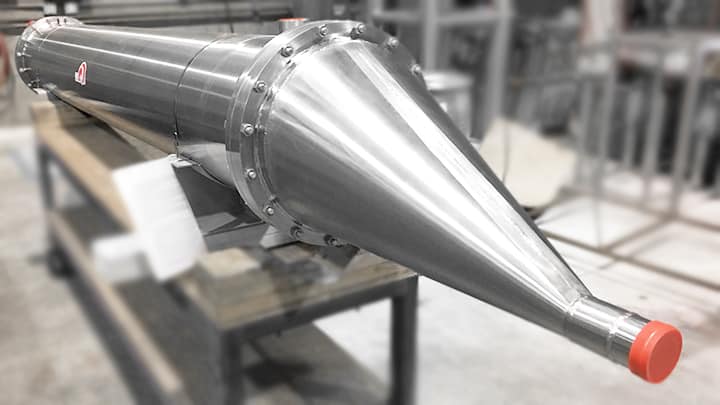Editor’s Note: This content was last updated 3/11/24.
Shell and tube heat exchangers offer a myriad of configurations to suit various needs. The crucial initial step in selecting the right exchanger for your business involves choosing the optimal combination of styles. Fabricators collaborate closely with manufacturers to pinpoint the specific requirements the exchanger must fulfill.
A pivotal decision that fabricators and manufacturers must make pertains to the type of channel, or bonnet, to employ in the shell and tube heat exchanger. This entails considering both the front channel, through which fluid enters the tubes, and the rear channel, where the fluid either exits the exchanger or undergoes another cycle.
Each type of channel—front or rear—is denoted by a designation set by the Tubular Exchanger Manufacturers Association (TEMA).
Varieties of Shell and Tube Heat Exchangers
When designing a shell and tube heat exchanger, the customer and fabricator will select the front channel, the shell type, and the rear head types. Each has its own merits and drawbacks, but aligning with the specifics of the application will guide the choice. Understanding the intended use of the exchanger is crucial for determining which qualities to prioritize.
For example, if the exchanger will handle toxic chemicals, particularly if hazardous materials will flow through both the tube side and the shell side, the N-type bonnet might be optimal. In this construction, the tubes, tube sheet, and shell are all welded together, reducing the risk of leaks. However, if welding everything together is unnecessary, there’s little advantage over other types. The N-type bonnet is challenging to clean and maintain, and replacing parts is more cumbersome compared to some alternatives.
If ease of cleaning and maintenance are top priorities, an A- or B-type designation would be advantageous. Both facilitate easy cleaning, as accessing the tube sheet is straightforward. These are the most common channel options, suitable for most exchanger applications. When choosing between the two, considerations should include the fluid pressure in the exchanger, the importance of tube cleaning, solution cleanliness, and cost.
The A-type is the easiest to clean because the tubes can be reached without disconnecting piping or removing the bonnet. Many manufacturers prefer A-type channels because they simplify cleaning the tube side, allowing the use of contaminated tube side fluids. However, this bonnet style has two gasketed seals, increasing the risk of leaks in high-pressure processes.
The B-type exchanger lacks the second seal, reducing the risk of leakage, making it more suitable for high-pressure processes. However, cleaning is more challenging because the bonnet needs removal to access the tubing. Manufacturers handling clean tube side fluids but dirty shell side solutions often choose this option, which is also more economical.
Lastly, the C-type provides access to the tubes without removing the piping, although it’s challenging to clean and maintain. It’s suitable for high-pressure applications and for handling hazardous substances on the tube side.
There are also D-type channels, primarily used for extremely high-pressure applications. Like the C-type, repairs are difficult because the tube bundle is attached to the bonnet. However, cleaning is not problematic as the tubes can be accessed without moving the pipes. It’s the most expensive option for the front channel.
Choosing the right bonnet is a critical decision in planning the fabrication of a shell and tube heat exchanger. While many exchangers perform well with an A-type or B-type channel box, there are instances where an N-type, C-type, or D-type may be preferable. Manufacturers should carefully discuss the options with their fabricator and understand the expected uses of their machine before making a final decision.
Machined vs. Fabricated Channels
Depending on the application, you’ll also need to decide if a machined channel or a fabricated channel is a better option.
Machined designs involve creating parts from solid stainless steel plate or forging through milling and drilling, ensuring cleanability and easy draining. On the other hand, fabricated designs are built from raw materials, offering larger volume for product hold-up and removable covers for tube cleaning, making them ideal for more viscous product applications. Depending on the specific requirements of your application, one may be more suitable than the other.
Enerquip provides various designs for both machined and fabricated channels, each offering unique benefits. Here, we compare the two.
Enerquip Simplifies the Decision-Making Process
If you’re in the market for a shell and tube heat exchanger but uncertain about the best style for your application, consult the experts at Enerquip. With experience in designing and fabricating shell and tube heat exchangers since 1985, we’ve likely worked with your exact process conditions. Contact us today or request a quote.
More from the Enerquip Blog
- Decoding the Delicate Balance of Sizing Shell and Tube Heat Exchangers
- Insulation Jackets: Enhancing Efficiency and Performance of Shell and Tube Heat Exchangers
- Discover the Hidden Brilliance of Metal Surfaces: Unleash the Power of Electropolishing
- Plant Steam vs. Culinary Steam vs. Pure Steam. What’s the difference?
- Point-of-Use Water Coolers in the Pharmaceutical Industry

